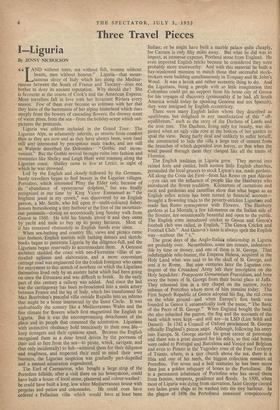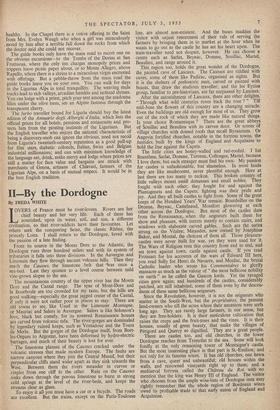Three Travel Pieces 1—Liguria
By JENNY NICHOLSON 66AND without trees, sea without fish, women without hearts, men without honour." Liguria—that moun- tainous sliver of Italy which lies along the Mediter- ranean between the South of France and Tuscany—does not bother to deny its ancient reputation. Why should she? She is favourite at the courts of Cook's and the American Express. More travellers fall in love with her luxuriant Riviera every season. Few of them ever become so intimate with her that they learn of the barrenness of her alpine hinterland which rises steeply from the bowers of cascading flowers, the drowsy scent of warm pines, from the sea—from the holiday-scape which out- pictures the postcards. Liguria was seldom included in the Grand Tour. The Ligurian Alps, as adamantly infertile, as remote from comfort then as they are now and as they have always been, were (and still are) intersected by precipitous mule tracks, and are still as Walpole described the Dolomites : " Gothic and incon- venient." But the Gothic revival brought ruins into fashion and romantics like Shelley and Leigh Hunt went roaming along the Ligurian coast. Shelley came to live at Lerici, in sight of which he was drowned.
Led by the English and closely followed by the Germans, hardy travellers began to find beauty in the Ligurian villages. Portofino, which interested -Pliny the Elder only. because of its "abundance of eponymous dolphins," but was finally recognised in our time by King Victor Emmanuel as " the brightest jewel in my crown," was discovered by an English parson, a Mr. Settle, who fell upon it—multi-coloured fisher- houses horseshoeing a tiny harbour at the foot of the mountain- ous peninsula—during an eccentrically long Sunday walk from Genoa in 1860. He told his friends about it and they came by yacht and mule to buy up its pretty hectares. Most of it has remained obstinately in English hands ever since. When sea-bathing and country life, views and picnics came into fashion, English tourists with bathing dresses and sketch- books began to penetrate Liguria by the diligence-full, and the Ligurians began reservedly to accommodate them. A Genoese architect studded the coast with neo-Florentine villas of un- rivalled ugliness and elaboration, and a more convenient carriage road was engineered for the foolish foreigner who came for enjoyment to this stretch of nowhere on which the Ligurians themselves lived only by an austere habit which had been going on since the Etruscans and was difficult to break. In the early part of this century a railway was added. And since the last war the carriageway has been re-broadened into a main artery between France and the leg of Italy, which has transformed Sir Max Beerbohm's peaceful villa outside Rapallo into an inferno that might be a home intersected by the Inner Circle. It was undoubtedly the scenery like a Mediterranean Wales and the fine climate for flowers which first magnetised the English to Liguria. But it was the uncompromising detachment of the place and its people that cemented the admiration. Ligurians with instinctive obstinacy hold tenaciously to their own life— keep strangers and their opinions apart. Because the English recognised them as a dour breed driven by the poorness of their soil to fare from the sea—to pirate, wreck, navigate, and (but only incidentally) to fish—admired them for their diligence and toughness, and respected their need to mind their own business, the Ligurian suspicion was gradually part-dispelled and a mutual admiration engendered.
The Earl of Caernarvon, who bought a large strip of the Portofino hillside, after a visit there on his honeymoon, could have built a house of local stone, plastered and colour-washed : he could have built a long, low white Mediterranean house with pergolas and patios and colonnades. IR could even have ordered a Palladian villa which would have at least been Italian; or he might have built a marble palace quite cheaply, for Carrara is only fifty miles away. But what he did was to import, at immense expense, Portland stone from England. He even imported English bricks because he considered they were probably more trustworthy. And with this material he built a bay-windowed mansion to match those that successful stock- brokers were building simultaneously in Torquay and St. John's Wood. It was a lavish and rather eccentric thing to do. And the Ligurians, being a people with so little imagination that Colombus could get no support from his home city of Genoa for his voyages of discovery (presumably if he had, all South America would today be speaking Genoese and not Spanish), they were intrigued by English eccentricity.
There were many English ladies whom they described as squilibrata, but delighted in any manifestation of this " off- equilibrium," such as the story of the Duchess of Leeds and the iron tree. The Duchess, living only for beauty, was dis- gusted when an ugly villa rose at the bottom of her garden to spoil the view. Being fairly deaf and unlikely to suffer herself, she constructed to hide the villa a large tree of cement from the branches of which depended iron leaves, so that when the wind passed through them they clanged like all the trams of Florence.
The English tradition in Liguria grew. They moved into ruined forts and castles, built austere little English churches, persauded the local grocers to stock Lipton's tea, made gardens. All along the Costa dei Fiori—from San Remo on past Alassio —you can see the influence of people like the Hanburys who introduced the flower tradition. Kilometres of carnations and cacti and gardenias and camellias show that what began as an English reflex action has been turned to financial account— brought a flowering trade to the poverty-stricken Ligurians and made San Remo synonymous with Flowers. The Hanbury gardens at La Mortala, a few kilometres on the Italian side of the frontier, are sensationally beautiful and open to the public. The English even introduced cricket to Genoa and Genoa's football club was called, in English, " The Genoa Cricket and Football Club." And Genova's team is always spelt the English way—without the " v." The great days of the Anglo-Italian relationship in Liguria are probably over. Nevertheless, some ties remain, indestruct- ible by time or money, and one of them is St. George. That indefatigable relic-hunter, the Empress Helena, acquired in the Holy Land what was said to be the skull of St. George, and sent it to Rome. But nine centuries later the Ligurian con- tingent of the Crusaders' Army left their inscription on the Holy Sepulchre : Praepotens Genuensium Praesidium, and bore away the bones of St. George from their burial place at Jaffa. They rehoused him in a tiny chapel on the narrow, rocky isthmus of Portofino where most of him remains today. The First Superb Republic of Genoa adopted his flag, the red cross on the white ground—and when Europe's first bank was founded in Genoa it automatically took the name, " The Bank of the Peers of St. George." When England bought the bank she also inherited the patron, the flag and the accounts of the bank which were kept—and still are—in LSD (Lire Soldi and Danari). In 1342 a Council of Oxford proclaimed St. George officially England's patron ,saisit. Although, following his entry into Europe, St. George started his great career of patronage and there was a great demand for his relics, so that odd bones were ceded to Portugal and Barcelona and Venice and Belgium and even to Pirano in the Yugoslav zone of the Free Territory of Trieste, where, in a tiny church above the sea, there is a fibia and one of his teeth,. the biggest collection remains at Portofino. For seven and a half centuries he has been more than just a golden reliquary of bones to the Portofinesi. He is a permanent inhabitant of Portofino who has saved them from famine, tempests, pestilence and floods. In 1500, when most of Liguria was dying from starvation, Saint George caused two laden grain ships to be washed into the tiny harbour. In the plague of 1696 the Portofinesi remained conspicuously healthy. In the Chapel there is a votive offering to the Saint from Mrs. Evelyn Waugh who when a girl was miraculously saved by him after a terrible fall down the rocks from which the doctor said she could not recover.
The guide books only leave the main road to escort one on the obvious excursions—to the Tombs of the Dorias at San Fruttuosa, where the only inn charges monopoly prices and trippers leave picnic paper about, or to Monte Allegro, above Rapallo, where there is a shrine to a miraculous virgin encrusted with offetings. But a pebble-throw from the main road the guide books leave you on your own. You can walk for days in the Ligurian Alps in total tranquillity. The weaving mule tracks lead to rich valleys, arcadian hamlets and isolated shrines. You can lodge with a priest, pitch your tent among the madonna lilies under the olive trees, see an Alpine fastness through the transparent cherry.
The furbo traveller bound for Liguria should buy the latest edition of the Annuario degli Alberghi d'Italia, which lists the official prices for all hotels, pensions and restaurants and pro- tects him from the pirating instincts of the Ligurians. But the English traveller who enjoys the national characteristic of being a discovery-snob can ignore the obvious, need not recoil from Liguria's twentieth-century reputation as a good pull-up for film stars, diabetic colonels, Italian, Swiss and Belgian industrial millionaires; and can with minimum knowledge of the language eat, drink, make merry and lodge where prices are still a matter for face value and bargains are struck with merchants of Genoa, artisans of Chiavari, farmers of the Ligurian Alps, on a basis of mutual respect. It would be in the best English tradition.



























































 Previous page
Previous page